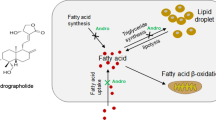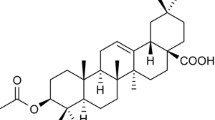Abstract
Hyperlipidemia is a known cause of coronary vascular diseases, which is a major cause of death in many parts of the world. Targeting several pathways that lead to increase in lipid profiles is of great potential to control diseases. 1H-indole-2-carboxamide derivatives were tested for their hypolipidemic activity at the molecular level in comparison with bezafibrate. The gene expression profiles of lipoprotein signaling and cholesterol metabolism and fatty acid metabolism PCR arrays were determined in rats with acute hyperlipidemia induced by Triton WR1339. Lipid profiles of serum from treated rats showed significant hypolipidemic effect by the compounds. Several genes of potential interest were reported to be overexpressed by Triton WR1339 including Apoc3, Apob, Hmgcs2, Apoa1, Apoe, Apof, acsl1, and Decr1. Most of the overexpressed genes were downregulated by N-(3-Benzoylphenyl)-1H-Indole-2-Carboxamide with significant decreases in Apoc3, Apob, Acaa2, Acsl1, and Slc247a5 gene expression levels. N-(4-Benzoylphenyl)-1H-Indole-2-Carboxamide and bezafibrate did not significantly affect the gene expression levels which were increased with acute hyperlipidemia induced by Triton WR1339. In conclusion, gene expression profiling identified the possible mechanism in which Triton WR1339 induces its acute hyperlipidemic effect which was reversed by the use of N-(3-Benzoylphenyl)-1H-Indole-2-Carboxamide.




Similar content being viewed by others
References
Wadhera RK, Steen DL, Khan I, Giugliano RP, Foody JM (2016) A review of low-density lipoprotein cholesterol, treatment strategies, and its impact on cardiovascular disease morbidity and mortality. J Clin Lipidol 10(3):472–489. doi:10.1016/j.jacl.2015.11.010
Taylor F, Huffman MD, Macedo AF, Moore TH, Burke M, Davey Smith G, Ward K, Ebrahim S. (2013) Statins for the primary prevention of cardiovascular disease. Cochrane Database Syst Rev doi:10.1002/14651858
Geldenhuys WJ, Lin L, Darvesh AS, Sadana P (2016) Emerging strategies of targeting lipoprotein lipase for metabolic and cardiovascular diseases. Drug Discov Today. doi:10.1016/j.drudis.2016.10.007
Luo M, Peng D (2016) The emerging role of apolipoprotein C-III: beyond effects on triglyceride metabolism. Lipids Health Dis 15(1):184
Al-Hiari Y, Shattat G, Al-Qirim T, El-Huneidi W, Sheikha GA, Hikmat S (2011) Antihyperlipidemic properties of novel N-(benzoylphenyl)-5-substituted-1H-indole-2-carboxamides in Triton WR-1339-induced hyperlipidemic rats. Molecules 16(10):8292–8304. doi:10.3390/molecules16108292
Shahwan M, Shattat G, Al-Qirim T, Sheikha GA, Al-Hiari Y, El-Huneidi W, Jarab A, Al-Najdawi M (2010) Synthesis and pharmacological evaluation of novel substituted and unsubstituted N-(benzoylphenyl)-1H-indole-2-carboxamides as potent antihypertriglyceridemic agents. Z Naturforsch C. 65(5–6):309–316
Al-Najdawi M, Al-Hiari Y, Al-Qirim T, Shattat G, Al-Zweri M, Abu Sheikha G (2014) Synthesis and pharmacological evaluation of novel unsubstituted indole-anthraquinone carboxamide derivatives as potent antihyperlipidemic agents. Z Naturforsch C 69(1–2):21–28
Yang Z, Cappello T, Wang L. (2015) Emerging role of microRNAs in lipid metabolism. Acta Pharm Sin B 5(2):145–150. doi:10.1016/j.apsb.2015.01.002
Sahebkar A, Watts GF (2013) New therapies targeting apoB metabolism for high-risk patients with inherited dyslipidaemias: what can the clinician expect? Cardiovasc Drugs Ther 27(6):559–567. doi:10.1007/s10557-013-6479-4
Nayak P, Panda S, Thatoi PK, Rattan R, Mohapatra S, Mishra PK (2016) Evaluation of lipid profile and apolipoproteins in essential hypertensive patients. J Clin Diagn Res 10(10):BC01–BC04
Wang YJ, Sun JB, Li F, Zhang SW (2006) Hyperlipidemia intensifies cerulein-induced acute pancreatitis associated with activation of protein kinase C in rats. World J Gastroenterol 12(18):2908–2913
Zheng C (2014) Updates on apolipoprotein CIII: fulfilling promise as a therapeutic target for hypertriglyceridemia and cardiovascular disease. Curr Opin Lipidol 25(1):35–39. doi:10.1097/MOL.0000000000000040
Kawakami A, Yoshida M (2009) Apolipoprotein CIII links dyslipidemia with atherosclerosis. J Atheroscler Thromb 16(1):6–11
Norata GD, Tsimikas S, Pirillo A, Catapano AL (2015) Apolipoprotein C-III: from pathophysiology to pharmacology. Trends Pharmacol 36(10):675–687 doi:10.1016/j.tips.2015.07.001
Liu X, Liu J, Liang S, Schlüter A, Fourcade S, Aslibekyan S, Pujol A, Graf GA (2014) ABCD2 alters peroxisome proliferator-activated receptor α signaling in vitro, but does not impair responses to fenofibrate therapy in a mouse model of diet-induced obesity. Mol Pharmacol 86(5):505–513. doi:10.1124/mol.114.092742
Khetarpal SA, Qamar A, Millar JS, Rader DJ (2016) Targeting ApoC-III to reduce coronary disease risk. Curr Atheroscler Rep 18(9):54. doi:10.1007/s11883-016-0609-y
Libby P (2015) Triglycerides on the rise: should we swap seats on the seesaw? Eur Heart J 36(13):774–776
Pollin TI, Damcott CM, Shen H, Ott SH, Shelton J, Horenstein RB, Post W, McLenithan JC, Bielak LF, Peyser PA, Mitchell BD, Miller M, O’Connell JR, Shuldiner AR (2008) A null mutation in human APOC3 confers a favorable plasma lipid profile and apparent cardioprotection. Science 322:1702–1705
Jensen MK, Rimm EB, Furtado JD, Sacks FM. (2012) Apolipoprotein C-III as a potential modulator of the association between HDL-cholesterol and incident coronary heart disease. J Am Heart Assoc 1:jah3–e000232. doi:10.1161/JAHA.111.000232
Doege H, Baillie RA, Ortegon AM, Tsang B, Wu Q, Punreddy S, Hirsch D, Watson N, Gimeno RE, Stahl A (2006) Targeted deletion of FATP5 reveals multiple functions in liver metabolism: alterations in hepatic lipid homeostasis. Gastroenterology 130(4):1245–1258
Anderson CM, Stahl A (2013) SLC27 fatty acid transport proteins. Mol Aspects Med 34(2–3):516–528. doi:10.1016/j.mam.2012.07.010
Sodhi SS, Ghosh M, Song KD, Sharma N, Kim JH, Kim NE, Lee SJ, Kang CW, Oh SJ, Jeong DK (2014) An approach to identify SNPs in the gene encoding acetyl-CoA acetyltransferase-2 (ACAT-2) and their proposed role in metabolic processes in pig. PLoS One 9(7):e102432. doi:10.1371/journal.pone.0102432 (eCollection)
Rudel LL, Lee RG, Parini P (2005) ACAT2 is a target for treatment of coronary heart disease associated with hypercholesterolemia. Arterioscler Thromb Vasc Biol 25(6):1112–1118
Author information
Authors and Affiliations
Corresponding author
Rights and permissions
About this article
Cite this article
Hamadneh, L., Al-Essa, L., Hikmat, S. et al. N-(3-Benzoylphenyl)-1H-Indole-2-Carboxamide decreases triglyceride levels by downregulation of Apoc3 gene expression in acute hyperlipidemic rat model. Mol Cell Biochem 431, 133–138 (2017). https://doi.org/10.1007/s11010-017-2983-3
Received:
Accepted:
Published:
Issue Date:
DOI: https://doi.org/10.1007/s11010-017-2983-3




